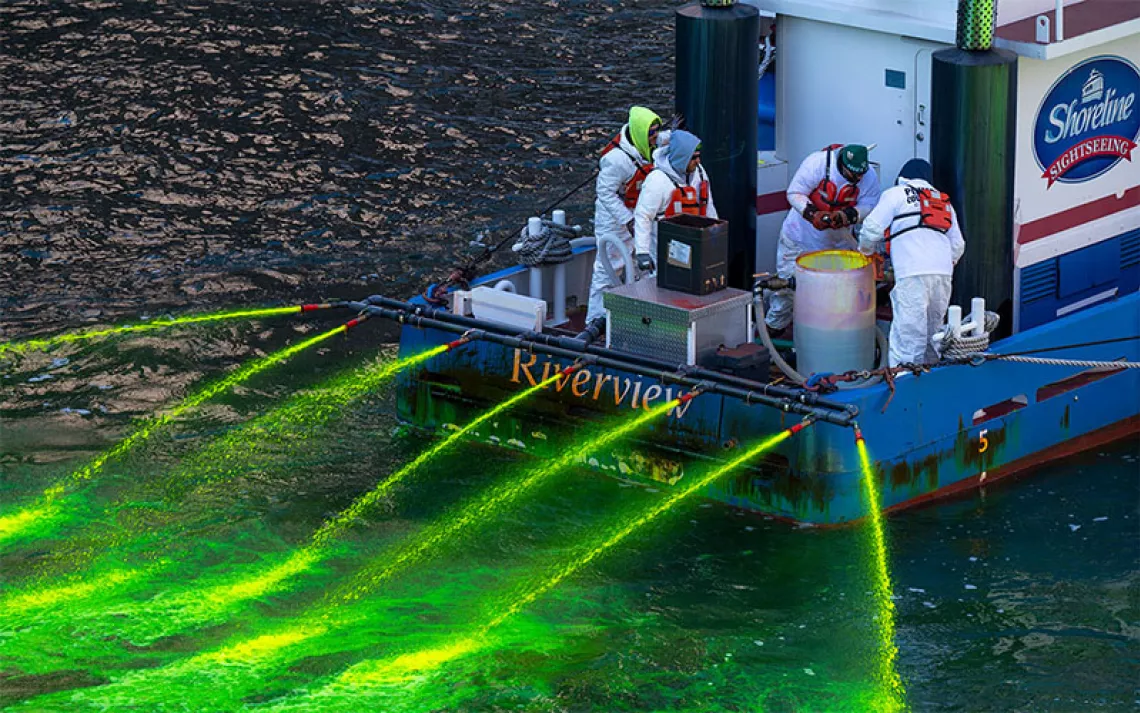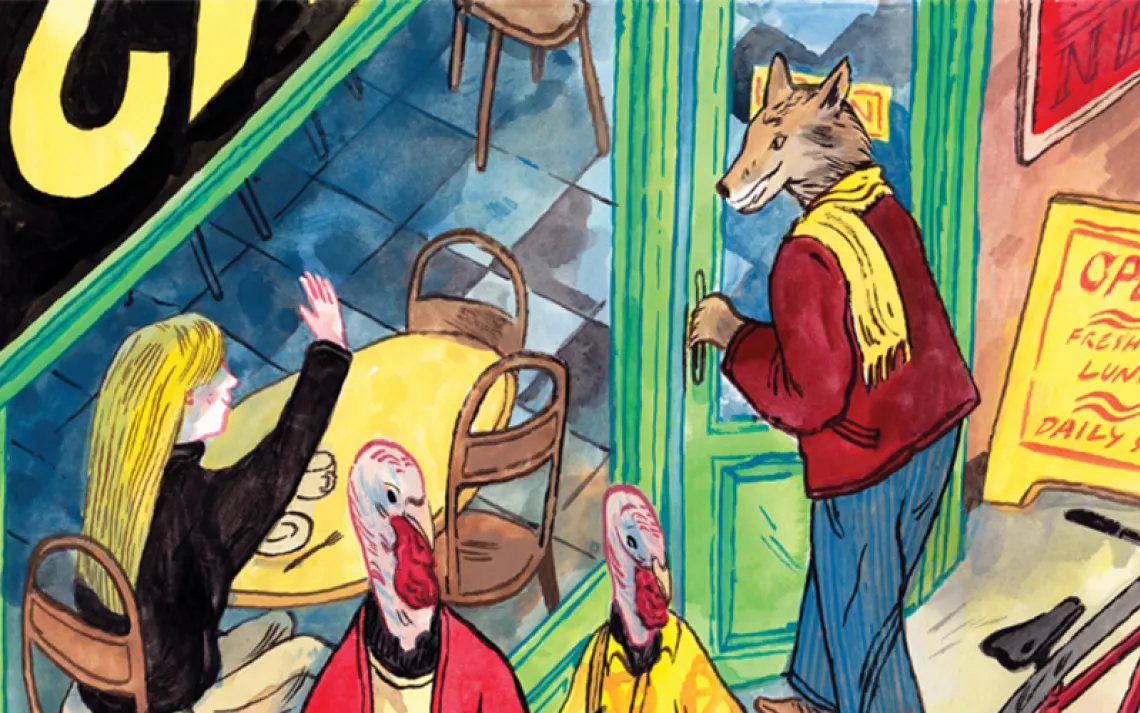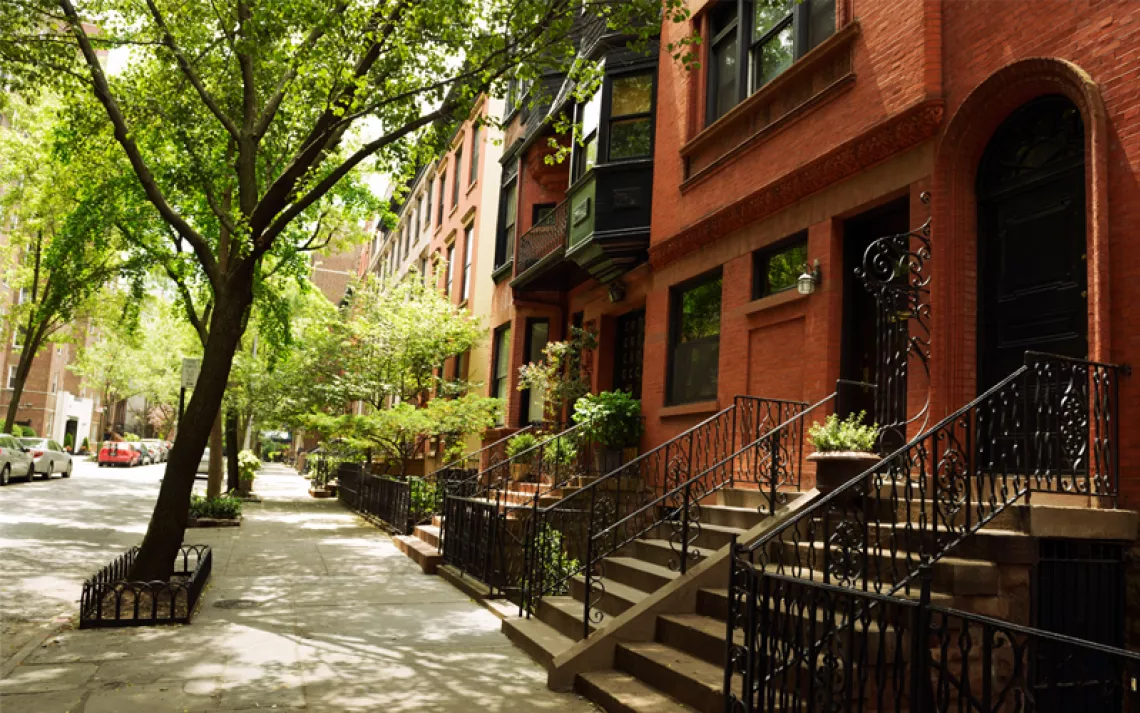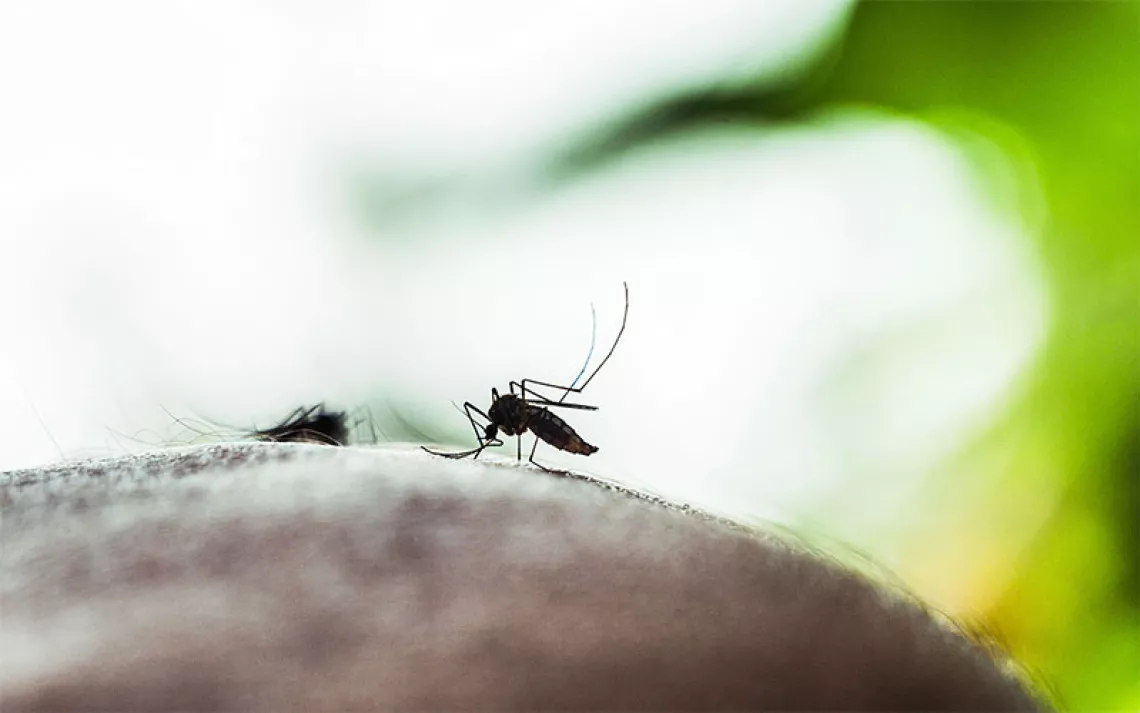Wilderness Is Closer Than You Think
Cities are full of wild remnants, if you know where to look
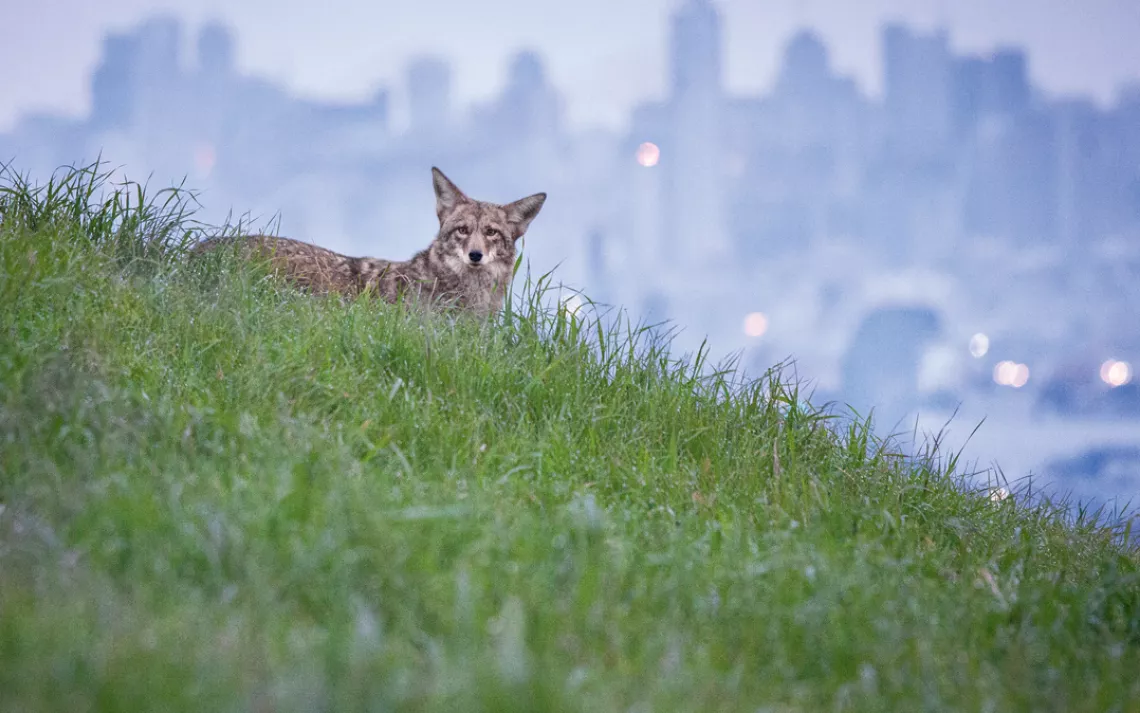
San Francisco coyote | Photo by Lori Eanes | Illustrations by Dieter Braun
IN MARCH 1868, a young Scottish immigrant named John Muir disembarked in San Francisco after sailing from New York City. The morning after he arrived, Muir approached a man carrying carpenter's tools on his shoulders and asked for "the nearest way out of town." Confused, the man set down his load and replied, "Where do you wish to go?" "Anywhere that's wild," Muir said. The carpenter directed him to the Oakland ferry. Muir crossed San Francisco Bay and then walked 300 miles to Yosemite Valley.
A century and a half later, Muir's desire has become a mantra among many urbanites. Each weekend, thousands of people pack up their cars and head to the mountains, the beaches, the desert—"anywhere that's wild." The once-unusual instinct that drove Muir to flee the city in search of wilderness has become commonplace.
I'm one of those searchers. For more than 40 years, I have lived in the city that John Muir fled, and I regularly feel the need to escape. I've been backpacking in the Sierra Nevada, mostly in the Emigrant Wilderness, since I was 20 years old, rediscovering a universe whose indifferent beauty and vast strangeness are all too easily forgotten amid life in the human hive. There is nothing like the sublime physical and spiritual disorientation of that first night alone at 8,000 feet, surrounded by harsh and unknown terrain, the ground hard on your back, the silence a roar, the stars undecipherable hieroglyphics, every noise in the darkness a bear, all familiar things gone—until after an hour or two the roar becomes just wind in the trees and you realize that you belong here as much as you do on your street. You realize that this, too, is your home. You have made it through the wilderness's hazing ritual and have found yourself in a bigger world.
Nothing like that experience can be found in a city. Yet after decades of exploring both the mountains and the town, I've come to realize that wilderness is located not only above the treeline and in other places "untrammeled by man." It can be found anywhere. Even the flattest, most sprawling, concrete-choked city gives access to it, if you know how and where to look. As Gary Snyder writes in The Practice of the Wild, "Great Brown Bear is walking with us, Salmon swimming upstream with us, as we stroll a city street."
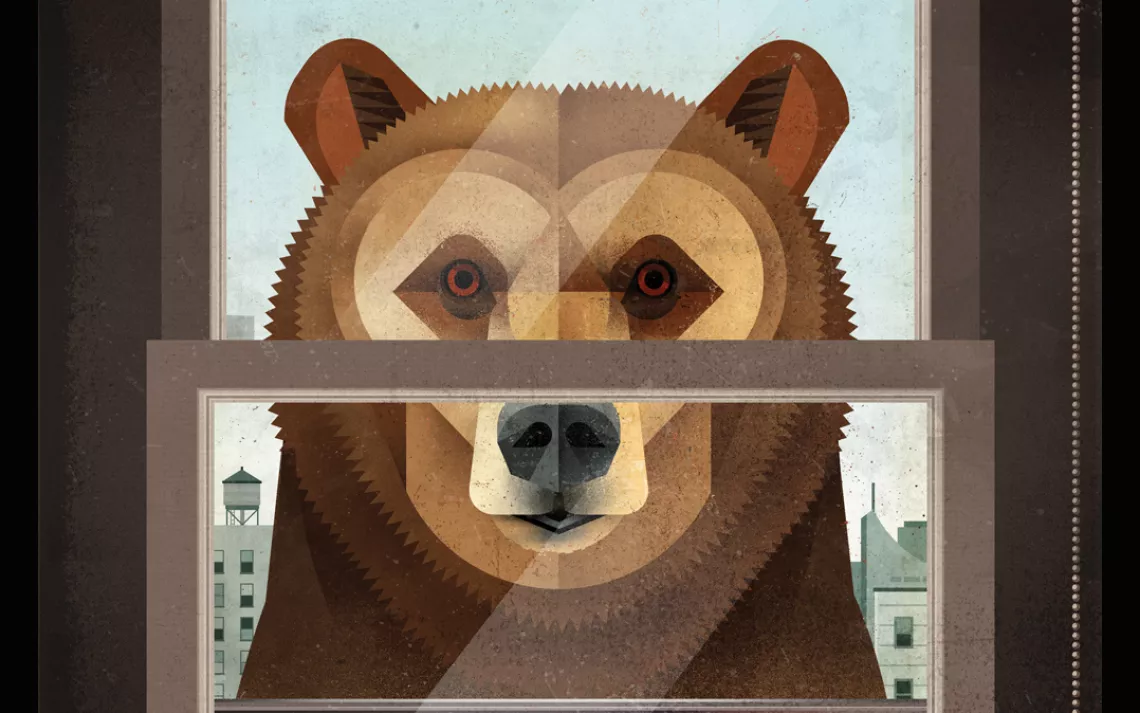
The most obvious way to discover wilderness in a city is to learn how to find those remnants of the natural world that have not been obliterated by concrete and steel. These holdouts range from wild animals to visible bedrock to trees to flowing streams—all manifestations of the primordial world. Equally important is learning to find the wilderness inside us—that childlike sense of wonder and celebration that, despite being paved over with mental cement, never completely gets lost. Without that inner openness, even the wildest place in the world can be as flat, stale, and spiritually unprofitable as a ring road in Houston.
With a beginner's mind, one can find wilderness anywhere. Every city reveals the universe in its own unique way, whether it be the glacier-polished schist boulders in Manhattan's Central Park or the mighty Mississippi River flowing beneath Chickasaw Bluff in Memphis, Tennessee. San Franciscans, it must be said, have it particularly easy, because here wilderness pops up around every corner. "At the end of our streets are stars," wrote George Sterling, the city's unofficial poet laureate in the early 20th century—and he could have added cliffs, canyons, and the biggest ocean on Earth. This jagged, unruly peninsula at the cracked end of the continent makes it impossible for its inhabitants to forget the untamed world.
The best place to get a shot of wilderness in San Francisco is Lands End, our mini Big Sur. From the spectacular cliff-top trail that runs along the city's northwest coast, the walker looks across that inexplicable break in the Coast Ranges—the only one for 600 miles—called the Golden Gate, then over to the towering red formations of radiolarian chert in the Marin Headlands. That most ghostly of rocks is made up of tiny organisms that sank to the bottom of prehistoric seas over tens of millions of years in what Rachel Carson called "the long snowfall." Time is an often-overlooked dimension of wilderness, and looking at the headlands across the Golden Gate, one is able to see an entire geological age frozen into a single moment.
If Lands End is the most dramatic wild place in San Francisco, the most cryptic and evocative is the Farallon Islands, 27 miles off Ocean Beach. This seething, wave-swept world of great white sharks and forbidding crags is visible from the porches of the cookie-cutter houses in the Sunset district; it's where 500th Avenue would be if human dominion extended that far. Fortunately it doesn't, but San Francisco actually owns the Farallones—making them the most untamed piece of real estate to be found within the borders of any city in the world. These islands are mere bumps on the horizon, but up close they are a permanent reminder of the savage power that—literally and figuratively—lurks just offshore.
Because San Francisco sits at the edge of the Pacific Ocean and is constantly buffeted by westerly winds, its air is an emissary from the sea; to take a breath is to absorb wilderness. One sometimes gets the strange feeling that the city is a floating island that has broken away from the continent and is drifting inexorably toward China. Its beloved and reviled fog contributes to this impression. One Wuthering Heights-like night, I found myself for the first time in an obscure natural area called Kite Hill, located on a flange of the hill called Twin Peaks above the Castro district. The fog was blowing in so fast that the glowing red letters of the Castro Theatre were obliterated in an instant, as if a giant finger had snuffed out a candle. A moment later the great, glittering, downtown-pointing arrow of Market Street vanished. I was alone in a moist gray void, unable to see more than a few feet in any direction. A metropolis of more than 850,000 souls surrounded me, but I could have been on an asteroid hurtling through space. The disorientation—one of the keys to experiencing wilderness—felt almost like the first night alone in the Sierra.
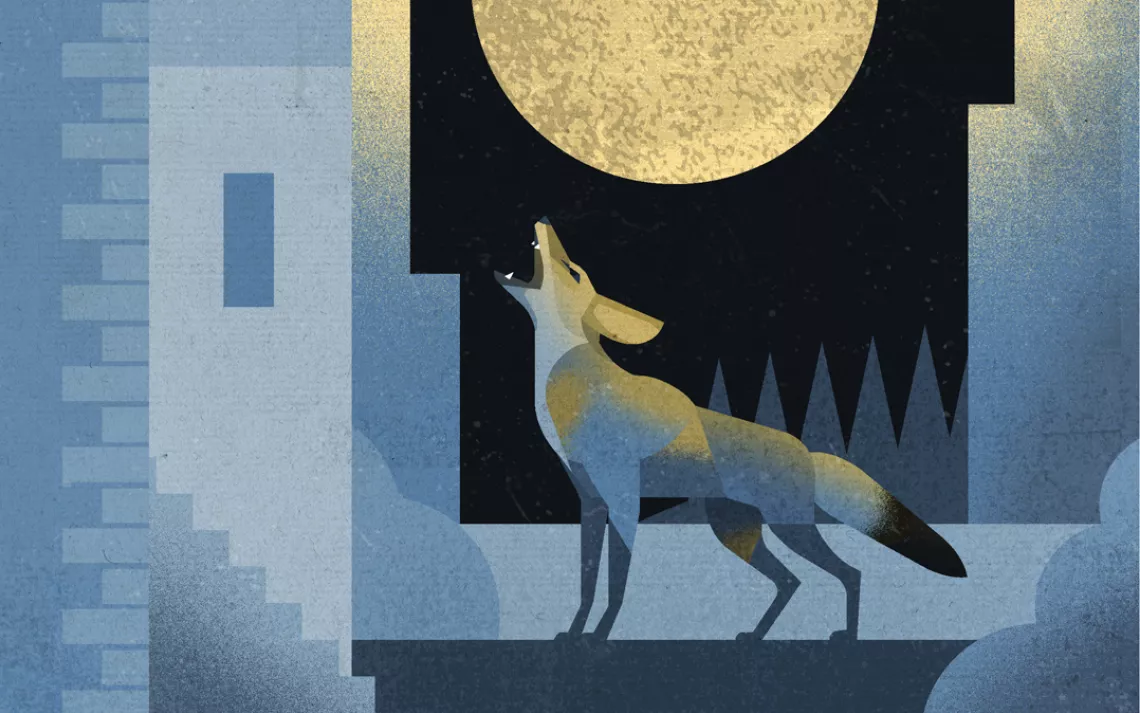
YOU DON'T HAVE TO SEEK OUT panoramic sites or be enveloped by weather to find wilderness. One tentative definition of wilderness—and there are as many as there are ponderosa pines in California's mixed coniferous forest—is "underlying reality." By that definition, wilderness is constantly breaking through all around, often in the most unexpected places. You just have to keep your eyes open. Take the intersection of California and Powell Streets atop Nob Hill, the only cable car crossing controlled by a human operator, who sits in a little wooden kiosk on the southeast corner. It's one of the most iconic, heavily photographed spots in the city. Yet just two blocks away is a derelict vacant lot that houses only a jagged outcropping of graywacke, the sedimentary rock common to the city's other great central hills. Every time I go by that unexpected formation, I am reminded that the same mysterious earth lies beneath our feet both on Powell Street and in the Sierra.
That sort of revelation is available in any city if you are attuned to its terrain and know something about its past. Knowing what a given part of Pittsburgh or New York or Paris looked like before humans arrived is a way of getting out of town without even crossing the street. History is a portal to wilderness, because it's not just about learning the past, but also about developing the imagination (another synonym for wilderness) to bring it alive.
For me the most magical encounter with urban wilderness is discovering freshwater bubbling out of the ground. I have been fascinated with secret urban waters since one night in the 1970s, when I was wandering through a field in the Presidio (now a national park) and heard a trickle. I pushed through an overgrown thicket behind an old fence and was astonished to find an actual spring flowing out of the ground. I didn't know it, but I had come upon El Polin, the most famous and historic spring in San Francisco, whose waters were revered in the Spanish and Mexican eras for their supposed fertility-enhancing properties. From then on, that trickle became the secret heart of the city for me.
El Polin Springs is now a destination. In 2012, the Presidio Trust, a federal agency created to preserve the area, daylighted it, clearing away the tangled brush, creating trails, excavating Spanish-era artifacts, and digging a new water channel. This admirable project has made the historic spring and its environs accessible to the general public and increased awareness of the beauty and value of riparian corridors. Still, I confess to having mixed feelings about it. The night I found the spring, it was a secret that belonged only to me. Wilderness always feels wilder when you discover it yourself.
But discovering it with others isn't bad, either. Two of the most euphoric and revelatory days I've ever had in San Francisco were spent with four experts on a quest to find the city's secret springs, seeps, and creeks. Led by the king of San Francisco water geeks, Joel Pomerantz (author of the irresistible book and atlas Seep City), we wandered all over town, finding little springs and creeks in the most unexpected and wondrous places. We walked through a marshy field below the concrete overhang of Portola Drive, home to the springs that once fed the now-vanished Precita Creek. We marveled at the gushing, spring-fed fountain in the courtyard of the Episcopal Church of St. Mary the Virgin in Cow Hollow, a now-swanky area once known as Spring Valley because of the streams that ran through it. We bushwhacked down to a flowing stream in a ravine behind a massive retirement home east of Stern Grove.
And as we wandered, we became kids again. We rediscovered another of the countless faces of wilderness: innocence. ("A man's maturity consists in rediscovering the seriousness one had when a child at play," Nietzsche wrote.) It was the same feeling I'd had when I spent an afternoon following a rivulet that kept disappearing and reappearing under a talus slide at Thousand Island Lake in the Sierra: Wilderness is not just indifferent or sublime; it's playful. Everything that you are has its corollary in the universe, for you are part of it and it is part of you. This is a truth that doesn't always come easily—you have to reach for it. But it is an enduring one that can survive traffic lights and chain stores.
I might fantasize about keeping San Francisco's natural treasures as a secret, overgrown garden to which only I have the key, but I don't really want that. Wilderness is not just for people who can afford to go backpacking in the Sierra or who have the leisure to wander around looking for fugitive signs of water. Every city dweller deserves the opportunity to experience the transformative beauty and power of the wild. To that end, San Francisco has made commendable attempts to open up its natural areas and parks, and to help its young people appreciate and understand the natural world. Efforts like the Greenagers program are spreading the gospel of fresh air and helping to build a new generation of environmentally conscious residents.
For urbanites, parks or less-manicured natural areas are the most important portals to wilderness. Apostles of wilderness sometimes condescendingly regard parks as pale imitations of the real thing, but this attitude ignores the continuum that is wilderness and slights the life-altering experiences that parks can inspire. A little wilderness is better than none. Marx Meadow and Hippie Hill in Golden Gate Park are so heavily used that it's hard to find a single untrampled blade of grass in them, but they are still open spaces with trees and grasses and vistas, breaks in the urban facade, oases that allow an escape from the bustling throngs. The pruned plane trees in the belle epoque remnant of the Music Concourse in the heavily trafficked eastern end of the park may inspire the child playing there to a future career in botany. The grown-up looking across beautiful but artificial Stow Lake can feel that same sense of the ineffable that I feel when sleeping underneath a granite ridge at Buck Lake.
WHICH TAKES US BACK to the wilderness within. No matter how refined we may think ourselves, at some level we are all still wild creatures, made up of the same materials as the mountains, the deserts, the oceans, the distant stars. "Wilderness" carries a connotation of chaos and anarchy, but that's misleading. Our inner wilderness is no more disorderly than the world itself is. A wild mind is a balanced mind. The wild world may be deeper and more heterogeneous than the city world, but the difference is only a matter of degree. The sense of wilderness is our birthright, and we can experience it anywhere. "The wilderness as a temple is only a beginning," Snyder writes. "One should not dwell in the specialness of the extraordinary experience . . . to enter a perpetual state of heightened insight." The real goal, he says, is to see all the land around us, whether in the country or in the city, as "part of the same territory—never totally ruined, never completely unnatural."
Of course there is still absolutely nothing like a face-to-face encounter with deep wilderness. Once at Buck Lake, I was awakened by the screaming call of a pack of coyotes racing unseen through the 3 A.M. darkness, the shrill sound moving fast along the mighty granite ridge across from my campsite, then fading into the distance. That sound still rings in my memory, a quicksilver affirmation of the strangeness and holiness of the world.
For many years, I had a backyard in San Francisco. It was a small yard with a typically small piece of available urban sky, a piece cut into an irregular trapezoid by my house and the school next door. My evening routine after work was to sit in the yard, listen to music, and look up at that little piece of sky. The clouds would blow in. The light would change and fade. Sometimes seagulls would wheel through. That was all. I didn't know it at the time, but those moments were what I lived for.
It is good to know that the coyotes are out there running, the big mountains standing, the alpine streams flowing. Now more than ever, in an age when children grow up staring at tiny screens all day and Earth itself is threatened by human heedlessness and folly, it's critically important to protect those places and get out to experience them as often as possible. But it is not necessary to live exclusively in the world of wild power. The world most of us inhabit is enough.
This article appeared in the May/June 2017 edition with the headline "The Wilderness Out Your Front Door."
Get Away Close to Home
San Francisco isn't the only major North American city where civilization and wildness intertwine. Here are some other urban nature spots.
Atlanta, Georgia: The Olmsted Linear Park is an emerald necklace of six mini-parks paralleling one of Atlanta's main thoroughfares, Ponce de Leon Avenue. Designed by Central Park architect Frederick Law Olmsted, the park chain includes old-growth trees that have been standing since before the Civil War.
Charleston, South Carolina: On Johns Island, just within the city limits, stands the Angel Oak, a southern live oak that is estimated to be 400 years old. This tree is a giant, with a trunk 25 feet in circumference, standing 65 feet tall, and with one branch measured at 187 feet long.
Chicago, Illinois: While New York City's Highline gets all the attention, Chicago also has a landscaped trail on an abandoned train track. The 606 trail starts near the Chicago River and runs westward, showcasing plants native to prairie ecosystems. With 17 ramps connecting to street level, the trail lets you pop back and forth between city and wild garden.
Detroit, Michigan: In the middle of the Detroit River, on the border between the United States and Canada, 982-acre Belle Isle Park offers a mix of developed attractions and undeveloped retreats. The island hosts a zoo, an aquarium, and a golf course as well as mature hardwood forests.
Louisville, Kentucky: Straddling Beargrass Creek, Cherokee Park (also designed by Olmsted) offers the usual amenities—playgrounds, fountains—and plenty of wild corners, too. Trails loop through remnant hardwood forests and meadows that remind us why Kentucky is called the Bluegrass State.
Phoenix, Arizona: The Phoenix Mountains Preserve, Sonoran Preserve, and South Mountain Park form a biological oasis of wildness amid a desert of sprawl. The 41,000-acre complex of Sonoran Desert is home to jackrabbits, roadrunners, and even coyotes—all within sight of skyscrapers and freeways.
Portland, Oregon: Just minutes from the hip boutiques and coffee shops of northwest Portland lies Forest Park, a 5,200-acre urban forest in the Tualatin Mountains. Trails for hikers and roads for mountain bikers wend through lush stands of hemlock, fir, and big-leaf maple.
Vancouver, British Columbia: It's easy to get lost in Stanley Park, with its thick forests (home to an estimated half a million trees, some more than a century old) and maze of trails. Located at the tip of downtown, on a peninsula jutting into Vancouver Harbour, the park offers plenty of opportunities for watching waterfowl and, if you're lucky, a migrating orca pod.
Teens Dig In to Urban Nature
On one of those San Francisco mornings when a dense fog blankets Telegraph Hill while brilliant sun pours down in the Mission, I set out to visit the Greenagers. Run by the city Recreation and Park Department, the program gives teens hands-on experiences with nature. Leaders and volunteers take the youths on educational field trips to parks and natural areas. The Greenagers go out several Saturdays a month from July to January, learning about the natural world, working with community organizations to protect local parks, and picking up valuable life skills.
I found them at Heron's Head Park, a 23-acre landfill just north of the Hunters Point neighborhood that was converted into a wetland. Program leaders, more than a dozen volunteers (many of them students), and seven Greenagers met in a circle to discuss the day's task, then donned rain boots and gloves and spread out along the marshy shore. Today they were weeding non-native plants, in particular an invasive one called sea lavender.
The program manager, Brenda Cartagena, said the students not only get their hands dirty most Saturdays, but also learn about general ecology, the natural phenomena of the specific park they're in, environmental justice, and other subjects they suggest themselves. "We've had students who have never been to the beach," Cartagena said. "Some of them will come out here and say, 'Wow, I didn't know there was anything like this in San Francisco.' These are the moments we all live for."
Sixteen-year-old Alex Soto, who attends Leadership High School, took a break from pulling up other weeds to show me what sea lavender looks like. Soto said he likes the Greenagers program so much he signed up two years in a row. "I've learned that plants play a big role in our lives," he said. "They help create what a park is. And they give life to other animals."
Byron Luk, a 15-year-old sophomore at Lowell High School, said the program has taught him to take responsibility for his actions. "Everything that you do, you leave a footprint. If you litter, the earth isn't getting any better." He added, "The best feeling is that no one knows we're doing this. Most people do things when people are watching, and they do them to look cool. I do this just to do it." —G.K.
 The Magazine of The Sierra Club
The Magazine of The Sierra Club
